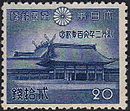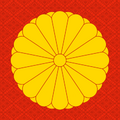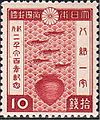Emperor Jimmu facts for kids
Quick facts for kids Jimmu |
|
|---|---|
| Emperor of Japan | |
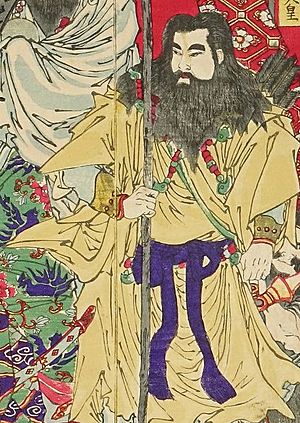 |
|
| Reign | legendary |
| Successor | Suizei |
| Born | legendary |
| Died | legendary |
| Burial | Unebi-yama no ushitora no sumi no misasagi (Nara) |
Emperor Jimmu (神武天皇, Jinmu-tennō) was the 1st emperor of Japan, according to the traditional order of succession. Jimmu is known as the founder of the Imperial dynasty.
There are no certain dates for this emperor's life or reign. The names and sequence of the early emperors were not confirmed as "traditional" until the reign of Emperor Kammu, who was the 50th monarch of the Yamato dynasty.
Contents
Traditional history
Jimmu is almost certainly a legend. His name and genealogy are recorded in the Kojiki and Nihonshoki. Jimmu is regarded as a direct descendant of the Shinto sun goddess, Amaterasu.
During reign of Emperor Jimmu, the capital of Japan was at Kashiwabara, Yamato at the foot of Mt. Unebi.
Events of Jimmu's life
The absence of information about Jimmu does not mean that he did or did not exist. There is very little data about the rulers of Japan before the reign of Emperor Bidatsu
The traditional story is that Jimmu came from Kyushu to Yamato Province on the island of Honshu. The story explains that he followed a three legged crow. He established his reign at Kashihara near Osaka.
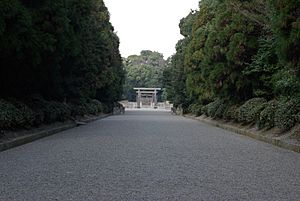
After his death
This emperor's official name after his death (his posthumous name) was regularized many centuries after the lifetime which was ascribed to Jimmu.
The actual site of his grave is not known. According to the Imperial Household Agency, the emperor is venerated at a memorial Shinto shrine (misasagi) in Kashihara at Nara. The mausoleum is located a short distance from Kashihara Shrine.
National holiday
In 1872, the Meiji government declared that February 11, 660 BC was the exact date on which the reign of Jimmu began. This was identified as the start of the Japanese nation. This mythical date was commemorated as the holiday Kigensetsu ("Era Day"). This national holiday was celebrated from 1872 to 1948.
The Kigensetsu events in 1940 were special. They celebrated what was believed to be 2,600 years since the start of Emperor Jimmu's reign.
There has been a similar Japanese national holiday since February 11, 1966. It is called National Foundation Day (Kenkoku Kinen no hi).
Related pages
| Preceded by –– |
Legendary Emperor of Japan Jimmu 660-585 BC (traditional dates) |
Succeeded by Emperor Suizei |
Images for kids
-
Emperor Jimmu, ukiyo-e by Tsukioka Yoshitoshi (1880)
-
Depiction of a bearded Jimmu with his bow and the golden kite. This 19th-century artwork is by Tsukioka Yoshitoshi.
-
Unebi Goryō, the mausoleum of Jimmu in Kashihara City, Nara Prefecture
-
The inner prayer hall of Kashihara Shrine in Kashihara, Nara, the principal shrine devoted to Jimmu
-
Emperor Shōwa and Empress Kōjun presiding the celebration of the 2600th anniversary of mythical foundation of the Empire in November 1940
See also
 In Spanish: Jinmu Tennō para niños
In Spanish: Jinmu Tennō para niños



